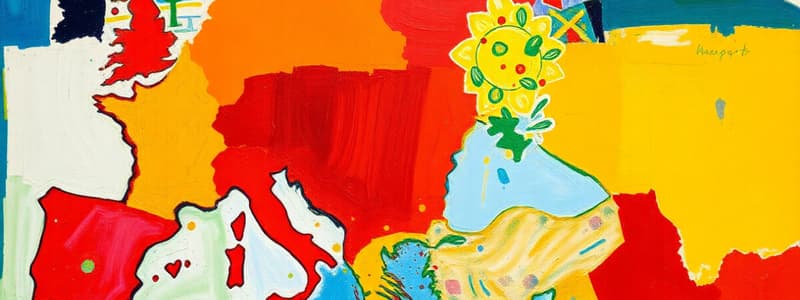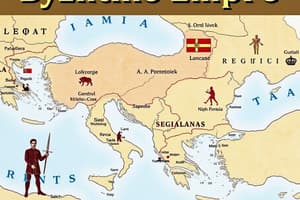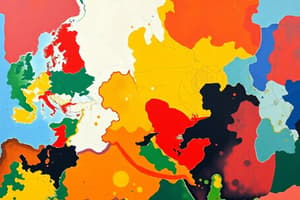Podcast
Questions and Answers
In what year did the Western Roman Empire officially fall?
In what year did the Western Roman Empire officially fall?
Which factor was LEAST significant in the decline of the Roman Empire?
Which factor was LEAST significant in the decline of the Roman Empire?
What is another name commonly used to refer to the Eastern Roman Empire?
What is another name commonly used to refer to the Eastern Roman Empire?
Constantinople, the capital of the Byzantine Empire, was originally known by what name?
Constantinople, the capital of the Byzantine Empire, was originally known by what name?
Signup and view all the answers
What was the predominant religion of the Byzantine Empire?
What was the predominant religion of the Byzantine Empire?
Signup and view all the answers
In 1054, the Byzantine Church formally separated from which religious body?
In 1054, the Byzantine Church formally separated from which religious body?
Signup and view all the answers
Which group's cultural assimilation with the Roman population is highlighted as particularly successful in the provided text?
Which group's cultural assimilation with the Roman population is highlighted as particularly successful in the provided text?
Signup and view all the answers
What key advantage did concrete offer to Roman builders compared to previous materials?
What key advantage did concrete offer to Roman builders compared to previous materials?
Signup and view all the answers
What was a significant consequence of the increasing availability of classical texts and the demand for secular clerics during the High Middle Ages?
What was a significant consequence of the increasing availability of classical texts and the demand for secular clerics during the High Middle Ages?
Signup and view all the answers
What was the primary purpose of guilds, initially formed by artisans and craftsmen, when teachers and students adopted a similar organizational structure?
What was the primary purpose of guilds, initially formed by artisans and craftsmen, when teachers and students adopted a similar organizational structure?
Signup and view all the answers
Prior to the High Middle Ages, what was the main characteristic of education in Western Europe?
Prior to the High Middle Ages, what was the main characteristic of education in Western Europe?
Signup and view all the answers
What was the 'Inquisition' in the context of the High Middle Ages, as described in the text?
What was the 'Inquisition' in the context of the High Middle Ages, as described in the text?
Signup and view all the answers
What factor primarily contributed to a growing dissatisfaction with the Church among the populace during the High Middle Ages?
What factor primarily contributed to a growing dissatisfaction with the Church among the populace during the High Middle Ages?
Signup and view all the answers
What was a significant consequence of Charlemagne's military campaigns in the 8th century CE?
What was a significant consequence of Charlemagne's military campaigns in the 8th century CE?
Signup and view all the answers
In the manorial system, what was the primary obligation of peasants to the lord of the manor?
In the manorial system, what was the primary obligation of peasants to the lord of the manor?
Signup and view all the answers
Which Roman Emperor's edict played a crucial role in the legalization of Christianity within the Roman Empire?
Which Roman Emperor's edict played a crucial role in the legalization of Christianity within the Roman Empire?
Signup and view all the answers
Following the fall of the Roman Empire, what contributed most significantly to the Church's rise as a powerful institution in medieval Europe?
Following the fall of the Roman Empire, what contributed most significantly to the Church's rise as a powerful institution in medieval Europe?
Signup and view all the answers
How did Thomas Aquinas integrate Aristotelian logic into Catholic doctrine?
How did Thomas Aquinas integrate Aristotelian logic into Catholic doctrine?
Signup and view all the answers
Which of the following was a key component typically found within a medieval manor house complex?
Which of the following was a key component typically found within a medieval manor house complex?
Signup and view all the answers
What factor primarily contributed to the division of Charlemagne's empire after his death?
What factor primarily contributed to the division of Charlemagne's empire after his death?
Signup and view all the answers
What was the primary function of monasteries in the spread of Christianity during the medieval period?
What was the primary function of monasteries in the spread of Christianity during the medieval period?
Signup and view all the answers
Besides religious instruction, what other form of education did the Church provide during the medieval era?
Besides religious instruction, what other form of education did the Church provide during the medieval era?
Signup and view all the answers
What is the significance of Thomas Aquinas's 'Summa Theologica'?
What is the significance of Thomas Aquinas's 'Summa Theologica'?
Signup and view all the answers
Which of the following was NOT a significant contribution of ancient Rome?
Which of the following was NOT a significant contribution of ancient Rome?
Signup and view all the answers
Roman concrete was particularly advantageous for building because it was NOT:
Roman concrete was particularly advantageous for building because it was NOT:
Signup and view all the answers
The extensive network of Roman roads primarily facilitated which of the following in the Roman Empire?
The extensive network of Roman roads primarily facilitated which of the following in the Roman Empire?
Signup and view all the answers
The Latin language held a prominent position in ancient Rome and Europe for all EXCEPT which of the following reasons?
The Latin language held a prominent position in ancient Rome and Europe for all EXCEPT which of the following reasons?
Signup and view all the answers
Roman law, emphasizing the 'rights of the people,' primarily focused on which specific group?
Roman law, emphasizing the 'rights of the people,' primarily focused on which specific group?
Signup and view all the answers
The Roman Republic was established with the aim of preventing:
The Roman Republic was established with the aim of preventing:
Signup and view all the answers
Historians during the Renaissance initially termed the Middle Ages the 'Dark Ages' primarily due to:
Historians during the Renaissance initially termed the Middle Ages the 'Dark Ages' primarily due to:
Signup and view all the answers
Despite the negative connotations associated with the term 'Dark Ages,' the Middle Ages also witnessed the rise of:
Despite the negative connotations associated with the term 'Dark Ages,' the Middle Ages also witnessed the rise of:
Signup and view all the answers
Feudalism in Europe primarily emerged as a response to:
Feudalism in Europe primarily emerged as a response to:
Signup and view all the answers
For serfs within the feudal system, a primary benefit, despite their lack of freedom, was:
For serfs within the feudal system, a primary benefit, despite their lack of freedom, was:
Signup and view all the answers
Study Notes
Roman Empire's Decline
- Fell in 476 AD after being overrun by Odoacer.
- Declined due to internal corruption and invasions by Germanic tribes (Vandals, Ostrogoths).
- Division of the empire by Diocletian and Constantine's move of the capital to Constantinople were major factors.
Byzantine Empire
- Eastern Roman Empire, continuing after the Western Empire's fall (476 AD) until 1453.
- Capital was Constantinople (originally Byzantium), established by Constantine.
- Predominantly Christian, separating from the Catholic Church in 1054 to form the Eastern Orthodox faith.
Fall of the Western Roman Empire and Germanic Migration
- Western Roman Empire's fall triggered conflicts between Germanic tribes (Vandals, Goths, Anglo-Saxons).
- Some tribes assimilated (e.g., Franks in France); others retained their tribal identities.
- Byzantine rulers (Eastern Roman Empire) held control for a time but were challenged by invasions (Persia, then Muslims).
Roman Art and Architecture
- Used marble, bronze, concrete, etc.
- Concrete was a Roman invention, enabling more elaborate buildings (e.g., Colosseum, domes).
- Employed painting, sculpture, mosaics, arches, and reliefs (three-dimensional appearance).
- Modern examples of Roman architecture exist (e.g., Lincoln Memorial).
Roman Inventions and Innovations
- Aqueducts: pipelines for fresh water to urban areas.
- Roads: facilitated travel, trade, and communication across the Empire.
- Concrete: easily portable, moldable, cheap, and strong building material.
- Medical Tools (clamps, tourniquets): improved battlefield medicine.
- Julian Calendar: more precise time-keeping system.
Roman Language, Law, and Government
- Latin: widespread language across Europe, used for official documents.
- Roman Law: focused on citizens' rights, representative republic government aimed to limit power.
- Literary achievements: impressive literature, blending fact with Roman mythology.
- Influenced modern political systems (elections, impeachment).
Middle Ages (476 AD-15th/16th centuries)
- Period characterized by wars, crises, religious conflicts, and disasters (Crusades, Black Plague, rise of feudalism).
- Historians once called it the Dark Ages, a term largely rejected today.
- Saw the beginning of universities and the development of scholasticism (philosophy inspired by Arab and Greek thought).
Feudalism
- Developed after the fall of Rome, as a system of land ownership based government.
- Kings gave fiefs (land) to nobles who pledged loyalty in exchange.
- Provided protection and sustenance for common people against invaders.
- Offered self-sufficient communities despite instability.
Charlemagne and the Holy Roman Empire
- Frankish King Charlemagne united much of Western Europe.
- Military campaigns led to cultural development and political stability.
- Christianity was emphasized to solidify control.
- His successors struggled to maintain unity, leading to the division of feudal kingdoms.
Manorial System
- Central feature of feudalism.
- Large estates granted to lords by the king.
- Peasants worked the land (demesne) in exchange for living on the manor.
- Daily lives: six days a week of labor; diet primarily bread and porridge.
- Manors had defensive fortifications, houses, churches, and other structures.
Spread of Christianity
- Gradual spread throughout the Roman Empire becoming the dominant religion in Western Europe.
- Constantines Edict of Milan (313 AD) legalized Christianity.
- Theodosius declared Christianity the official religion of the Roman Empire.
- Monasteries were established for education and conversion.
Church's role in the Middle Ages
- Powerful institution in society, influencing political decisions.
- Provided shelter, food, and protection to many.
- Offered education and taught various subjects.
- Controlled access to classical learning; initially clergy-centered, then town schools emerged.
- Faced challenges from heresy, such as the Cathar crusade.
Thomas Aquinas
- Important philosopher and theologian (1225-1274).
- Used Aristotle's logic to support Catholic doctrines in a way suitable to the Church.
- Wrote "Summa Theologica", a manual on theology.
- Canonized as a saint for his contributions to philosophy and theology.
High Middle Ages' Changes
- Population growth and increased literacy.
- Development of urban centers.
- Secular education increased, leading to questioning church power and corruption.
- Heresy accusations and inquisition against heretics like the Cathars.
Medieval Education
- Initially limited to clergy in monasteries (copy/translate texts).
- Growing need for secular clerics, record-keepers, and town development increased demand for broader education.
- Schools and universities emerged (e.g., Oxford, Cambridge) combining classical knowledge with the medieval world .
- Univs created/helped by teacher and student associations (universitas).
Studying That Suits You
Use AI to generate personalized quizzes and flashcards to suit your learning preferences.
Description
Explore the factors contributing to the decline of the Roman Empire, including internal corruption and invasions. Discover the resilience of the Byzantine Empire and its impact after the fall of the Western Empire. Dive into the cultural shifts and conflicts shaped by Germanic migrations.




